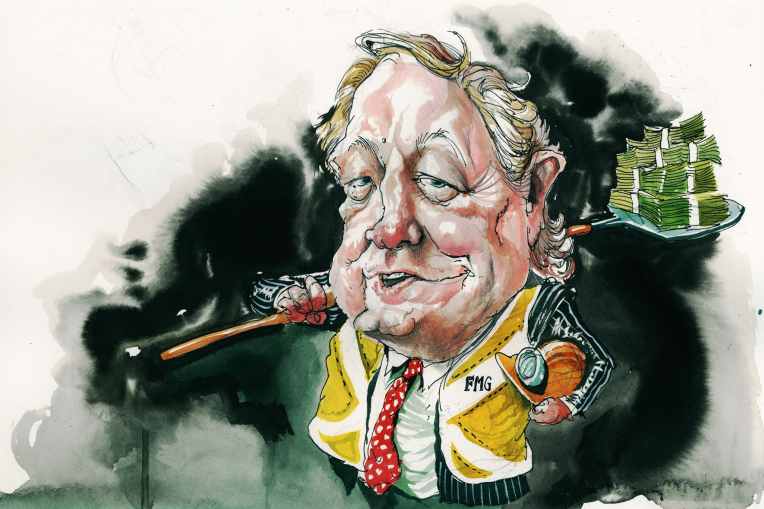How our very richest tripled their fortunes in a decade
by James ThomsonCrisis? What crisis?
It took more than 12 months for the wealth of Australia’s 20 richest people to recover in the wake of the financial crisis. But COVID-19 has barely dented the fortunes of this elite group.

Indeed, the latest update of the Rich 200's top 20 published on Friday by AFR Weekend shows their total wealth has surged almost 30 per cent in the last 12 months. That’s largely thanks to a small group of billionaires leveraged to two sectors that have proven extraordinarily resilient throughout the pandemic: iron ore and technology.
For the first time since 2015, mining queen Gina Rinehart regains her title as the richest Australian after her wealth surged 53 per cent to a staggering $21.2 billion. The fortune of fellow iron ore magnate Andrew Forrest jumped 120.6 per cent to $17.6 billion.
Atlassian co-founders Mike Cannon-Brookes and Scott Farquhar have also breezed through the crisis, with their fortunes almost doubling to $18.7 billion and $18.5 billion respectively; Atlassian stock is up almost 40 per cent since the market bottomed in March.
The quartet is symbolic of the steady globalisation of the Rich List. A decade ago, when Rinehart’s fortune was just $4.75 billion, half of the 20 richest people in Australia ran domestically focused businesses; in 2020, that proportion shrunk to 30 per cent.
Sure, the world remains an unpredictable place – it’s not hard to imagine how the simmering US-China trade tensions could create landmines for the Rinehart and Forrest on one side, and Cannon-Brookes and Farquhar on the other.
But the alternative view is that as the global economy is reshaped by the shock of the coronavirus, this foursome could emerge stronger still.
Could China, suddenly so aggressive in its relations with the rest of the world, seek to drive its economic growth even harder, relying at least in part on steel made from Australian iron ore?
And in a world where remote, cloud-based working becomes the norm, won’t the digitisation of global business gain even more momentum?
One of the best things about a Rich List running for almost 40 years is the historical context that lets us assess the big themes shaping the current list.
History suggests COVID should have shaken the list to the core, just like the last great global economic dislocation did.
It was in 2009 when the GFC really hit Australia’s Rich List, when the wealth of the 20 richest people plunged 27 per cent to $45.1 billion in 2009 from $61.9 billion the year before.
Andrew Forrest suffered the most dramatic fall, as his fortune plummeted to $2.4 billion from $9.4 billion as iron ore prices fell, and weighed down by the debt load he’d taken on at the start of his journey to build Fortescue Metals Group.
By the time of the 2010 Rich List, the fortune of the nation’s 20 wealthiest billionaires was back up to $56.3 billion, as the likes of Frank Lowy bounced back strongly.
But on the top-line numbers at least, that recovery looks positively glacial compared with this crisis. In 2019, the top 20 members of the Rich List were worth $146.4 billion; according to today’s special update, the richest 20 are now worth $188.6 billion.

Now, arguably those totals don’t necessarily tell the whole story.
Nine of the 20 have suffered a decline in wealth the past year, including Lowy, shopping centre king John Gandel, and Crown Resorts major shareholder James Packer. Mining chief Ivan Glasenberg also proves that not every resource house has come through COVID unscathed; his fortune fell 16 per cent to $5.5 billion.
Nevertheless, the 2020 total of $188.6 billion for the list’s 20 richest billionaires is astounding when considered in the context of the last decade.
Between 1990 (when we were only developing the full picture of wealth in this country) and 2000 the total wealth of the 20 wealthiest members of the Rich List grew 221 per cent. In the next decade, the same number grew 99 per cent.
But between 2010 and 2020, the wealth of the top 20 grew a staggering 235 per cent.
To use a couple of crude comparisons, the ASX 200 has risen 35 per cent the past decade, while the median price of a home in Sydney has climbed about 40 per cent.
So what turbocharged the top echelons of Australian wealth? China and technology.
Since the 2010 Rich List, the fortunes of Rinehart, Forrest and fellow iron ore magnate Clive Palmer have increased by a total of $35 billion. China is also the main source of wealth for the fourth-richest Australian, property investor Hui Wing Mau. His Hong Kong listed group, Shimao Property, has surged more than 50 per cent in the last 12 months, taking his fortune to $17.8 billion.

On the technology front, Cannon-Brookes and Farquahar stand out; Atlassian was eight years old in 2010, but the founders were yet to crack the Rich List. Cannon-Brookes and Farquahar account for another $37 billion of that $132 million gap between the total wealth of the top 20 in 2010 compared with this year.
While coronavirus makes it difficult to predict the next few years with any degree of certainty, it seems a safe bet that the strength of China’s economic ambitions and the rise of cloud computing can further support the growth of our top fortunes.
While the fortunes of Rinehart, Forrest and Palmer are of course exposed to movements in the iron ore price, the outlook is relatively supportive. Supply constraints weigh heavily on output from Australia’s great iron ore rival, Brazil, while China is likely to keep stimulating its economy as its gathers steam after the coronavirus.
But for Rinehart and Forrest to further build their fortunes at the rate of the past decade would likely require meaningful expansion to their current empires.
Forrest’s Fortescue is in the midst of a mammoth construction project, but this is about replacing existing production as mines reach the end of their lives, rather than adding more capacity. Rinehart’s Roy Hill operation has boosted its output to 60 million tonnes from 55 million tonnes through the construction of a magnetic separation plant and, having only shipped its first tonnes five years ago, could well find other ways to boost production.
Cannon-Brookes and Farquhar might have a smoother path to building their fortunes – even allowing for the 183 per cent rise in Atlassian’s share price in the past two years.
While consumers have been quick to adopt digital technologies and applications the past decade, businesses have been comparatively slower. You only need to think of the way the big banks still rely on manual processing of mortgages in low-cost countries like India and the Philippines to see the digitisation of the enterprise has some way to go.
But COVID-19 has forced rapid changes to the way business works and level of technology it employs and it’s almost unthinkable that the adoption of online tools won’t accelerate further from here.
Atlassian’s products, which at their core are designed to help an organisation’s teams, projects and technology become more efficient, should benefit from both the digitisation of business and the adoption of new ways of working in a post-virus world, where teams are likely to be more geographically dispersed, and less physically connected.
Clearly, with the Atlassian stock price up 40 per cent since the end of March, there’s plenty of this potential growth built into the value of the company. But for an 18 year-old-company, Atlassian is arguably just coming into its own.